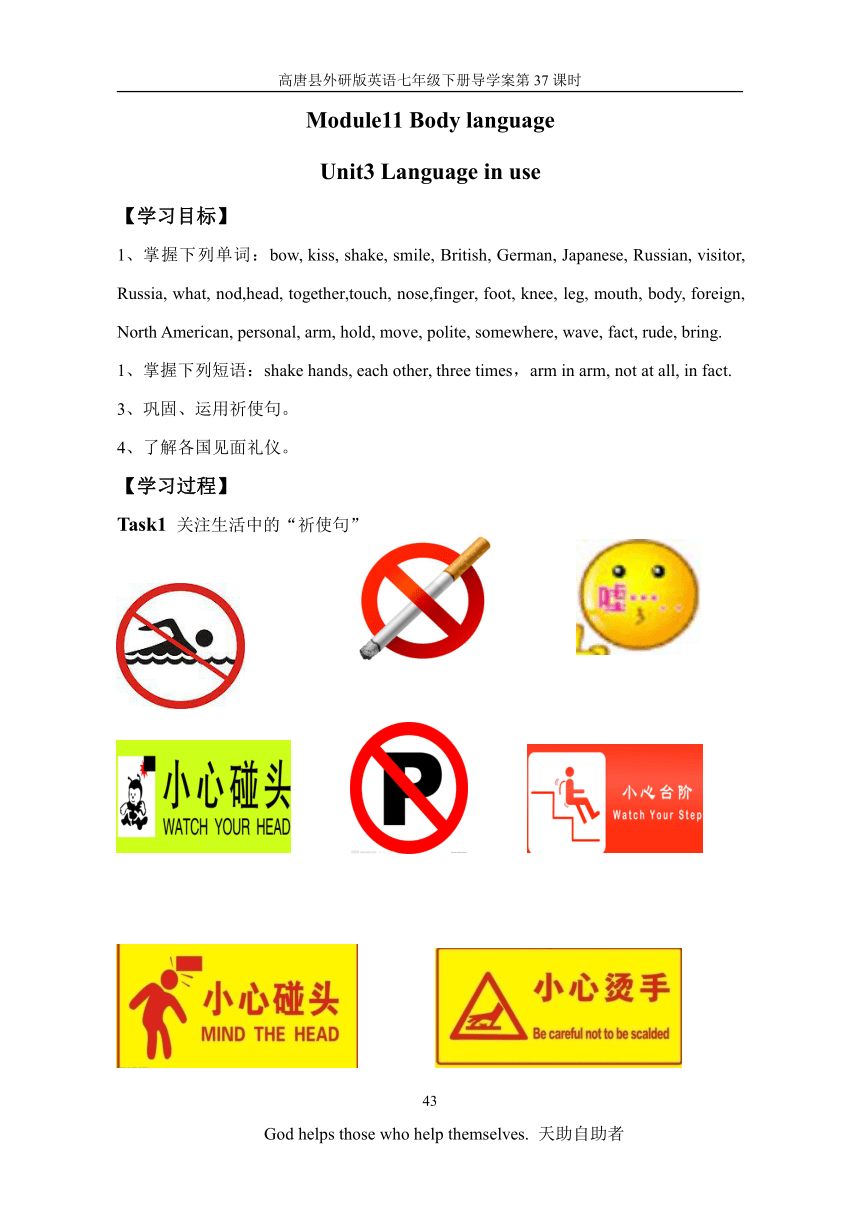七年级下>Module 11 Body language>Unit 3 Language in use
文档属性
| 名称 | 七年级下>Module 11 Body language>Unit 3 Language in use |  | |
| 格式 | zip | ||
| 文件大小 | 1.3MB | ||
| 资源类型 | 教案 | ||
| 版本资源 | 外研版 | ||
| 科目 | 英语 | ||
| 更新时间 | 2013-03-11 09:04:16 | ||
图片预览

文档简介
Module11 Body language
Unit3 Language in use
【学习目标】
掌握下列单词:bow, kiss, shake, smile, British, German, Japanese, Russian, visitor, Russia, what, nod,head, together,touch, nose,finger, foot, knee, leg, mouth, body, foreign, North American, personal, arm, hold, move, polite, somewhere, wave, fact, rude, bring.
掌握下列短语:shake hands, each other, three times,arm in arm, not at all, in fact.
3、巩固、运用祈使句。
4、了解各国见面礼仪。
【学习过程】
Task1 关注生活中的“祈使句”
Task 2 祈使句小结
①祈使句一般没有___________,说话的对象都是第二人称你或你们;
②以___________ 原形开头,无时态和数的变化;
③祈使句的否定形式是在动词原形前加__________;
④ 在表达请求时,可以加上_________,表达较强烈的语气时,可以用_________。
Task3 完成下列短语.
①可以_____________________ ② 臂挽臂地________________________
③吻三次 ____________________④与---握手_________________________
⑤指着 ______________________⑥对不起 __________________________
⑦ show respect ________________⑧ say hello _________________________
⑨ 按时__________________⑩ stand in line _________________________
⑾ clean and tidy the lab__________________ ⑿bring --- into --- ______________
☆温馨提示:以上短语都能在本单元找到。
Task4 完成下面单词
I'm welcoming the v_________, how do I do that?
In R_______, people usually kiss three times.
We Chinese often s_______ hands and s_______ when we meet other people.
That's b_______ people do different things in different countries.
In the US, some people k______ or h_______each other.
In India people put their hands t________ and n______ their hands.
Maori people t______noses when they meet.
Our new f_______ students are going to arrive very soon.
Please give them more p___________space.
South Americans sometimes h__________your arm when they talk to you.
In some places, it's p________ to look at people when you talk.
In other countries, it's r______ to look at people when you talk.
W______ to say goodbye is all right in China.
☆温馨提示: 以上句子都是课本上的,做完以后可以查课本核对。
修订人:孙海秀
Unit3 Language in use
【学习目标】
掌握下列单词:bow, kiss, shake, smile, British, German, Japanese, Russian, visitor, Russia, what, nod,head, together,touch, nose,finger, foot, knee, leg, mouth, body, foreign, North American, personal, arm, hold, move, polite, somewhere, wave, fact, rude, bring.
掌握下列短语:shake hands, each other, three times,arm in arm, not at all, in fact.
3、巩固、运用祈使句。
4、了解各国见面礼仪。
【学习过程】
Task1 关注生活中的“祈使句”
Task 2 祈使句小结
①祈使句一般没有___________,说话的对象都是第二人称你或你们;
②以___________ 原形开头,无时态和数的变化;
③祈使句的否定形式是在动词原形前加__________;
④ 在表达请求时,可以加上_________,表达较强烈的语气时,可以用_________。
Task3 完成下列短语.
①可以_____________________ ② 臂挽臂地________________________
③吻三次 ____________________④与---握手_________________________
⑤指着 ______________________⑥对不起 __________________________
⑦ show respect ________________⑧ say hello _________________________
⑨ 按时__________________⑩ stand in line _________________________
⑾ clean and tidy the lab__________________ ⑿bring --- into --- ______________
☆温馨提示:以上短语都能在本单元找到。
Task4 完成下面单词
I'm welcoming the v_________, how do I do that?
In R_______, people usually kiss three times.
We Chinese often s_______ hands and s_______ when we meet other people.
That's b_______ people do different things in different countries.
In the US, some people k______ or h_______each other.
In India people put their hands t________ and n______ their hands.
Maori people t______noses when they meet.
Our new f_______ students are going to arrive very soon.
Please give them more p___________space.
South Americans sometimes h__________your arm when they talk to you.
In some places, it's p________ to look at people when you talk.
In other countries, it's r______ to look at people when you talk.
W______ to say goodbye is all right in China.
☆温馨提示: 以上句子都是课本上的,做完以后可以查课本核对。
修订人:孙海秀
同课章节目录
- Module 1 Lost and found
- Unit 1 Whose bag is this?
- Unit 2 Are they yours?
- Unit 3 Language in use
- Module 2 What can you do ?
- Unit 1 I can play the piano
- Unit 2 I can run really fast
- Unit 3 Language in use
- Module 3 Making plans
- Unit 1 What are you going to do at the weekends?
- Unit 2 We're going to cheer the players.
- Unit 3 Language in use
- Module 4 Life in the future
- Unit 1 Everyone will study at home
- Unit 2 Every family will have a small plane.
- Unit 3 Language in use
- Module 5 Shopping
- Unit 1 What can I do for you?
- Unit 2 You can buy everything on the Internet
- Unit 3 Language in use
- Module 6 Around town
- Unit 1 Could you tell me how to get to the Nationa
- Unit 2 The London Eye is on your right.
- Unit 3 Language in use
- Revision module A
- Module 7 My past life
- Unit 1 I was born in a small village.
- Unit 2 I was born in Quincy.
- Unit 3 Language in use
- Module 8 Story time
- Unit 1 Once upon a time….
- Unit 2 Goldilocks hurried out of the house.
- Unit 3 Language in use
- Module 9 Life history
- Unit 1 He left school and began work at the age of
- Unit 2 He decided to be an actor.
- Unit 3 Language in use
- Module 10 A holiday journey
- Unit 1 What did you do?
- Unit 2 This morning we took a walk.
- Unit 3 Language in use
- Module 11 Body language
- Unit 1 They touch noses!
- Unit 2 Here are some ways to welcome them.
- Unit 3 Language in use
- Module 12 Western music
- Unit 1 It's so beautiful!
- Unit 2 Vienna is the centre of European classical
- Unit 3 Language in use
- Revision module B
